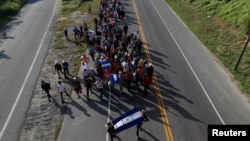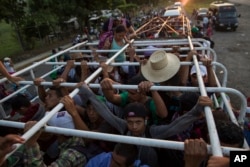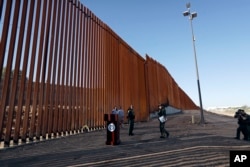The Trump administration is reported to be considering a new executive order aimed at blocking asylum seekers and immigrants from crossing the U.S.-Mexico border, as a caravan of migrants continues to make its way north through Mexico.
News reports quoting unnamed administration officials say authorities are weighing a range of administrative and legal actions on grounds of national security to restrict the ability of migrants to seek asylum.
Although no decision has reportedly been made yet, immigration attorneys told VOA the move would be quickly challenged in court.
Some reports have suggested a complete border closure is under consideration, but analysts consider such a move politically impossible because of the billions of dollars in commerce between the U.S. and Mexico.
Instead, the administration is likely aiming for a narrower action particularly targeting asylum seekers who arrive in the United States without traveling through regular border crossings.
Homeland Security Secretary Kirstjen Nielsen told reporters in California Friday that “everything is on the table’’ as the administration considers new measures to stop illegal immigration.
The development comes Friday as Mexico increased its efforts to stop the caravan from reaching the United States, offering temporary identification papers and jobs to migrants who register for asylum in Mexico. Mexican President Enrique Pena Nieto said migrants must remain in the southern states of Chiapas and Oaxaca to qualify for the plan.
Leon Fresco, a former U.S. Department of Justice official and immigration attorney, said any presidential action aimed at curbing the ability of people who are able to reach the U.S. from seeking asylum would face a difficult legal battle — even if it relies on the president’s travel ban, which was upheld by the Supreme Court.
Fresco says that anyone who reaches U.S. soil, legally or illegally, has the right to request asylum.
“That travel ban statute is irrelevant. It doesn’t apply to you anymore,” he said.
On Friday, Omar Jadwat, director of the ACLU’s Immigrants’ Rights Project, said It is “disgraceful the Trump administration would even consider extending the travel ban.
“It would mean refusing to protect people who can prove they are fleeing persecution. That would be a huge moral failure and any plan along these lines will be subject to intense legal scrutiny.”
According to the United Nations, blocking asylum requests is illegal. Such action also violates U.S. law in the form of the Convention against Torture. The convention is an international human rights treaty that prohibits torture and degrading treatment against all human beings. The General Assembly adopted it in 1984, and the U.S. ratified the treaty in October 1994.
On Friday, the Pentagon approved a request by the Department of Homeland Security to send several hundred troops to the U.S.-Mexico border in what is described as a support role. A statement released Friday said personnel will support the border patrol with planning assistance, medical teams and the construction of temporary housing, along with other support duties.
They will join more than 2,000 members of the National Guard already deployed to the area who are providing support for border patrol agents.
The ramped up efforts by the administration come as reports indicate the number of migrants in the caravan are dropping, from around 7,000 a few days ago to about 3,000 now.
Officials say nearly 1,700 migrants have already dropped out and applied for asylum in Mexico. A few hundred weary migrants have accepted Mexican government offers to transport them back to their home countries.
Most of those traveling north are from Honduras. There has been no evidence to back up President Donald Trump's claim that "Middle Easterners" are also with the group.
Carla Babb contributed.









